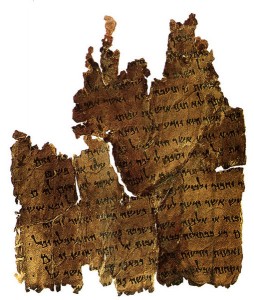Eruv and Sectarianism in Ancient Judaism: A Problematic Reading

Zadokite Fragments, also known as Damascus Document. http://commons.wikimedia.org/wiki/File:The_Damascus_Document_Scroll.jpg
There is an additional passage in the Zadokite Fragments (11:4-5) which has been taken by some as relevant to our discussion. This enigmatic passage provides that:
No one shall enter partnership (yit`arev) by his own volition on the Sabbath.
This law has given rise to several emendations. We should note that a Qumran manuscript of this text, no 4Q270 6 v 1 confirms the reading of the medieval Cairo genizah manuscript. Years before this Qumran manuscript was published, I maintained that one should adhere to the text as it stands and interpret the passage as prohibiting declaring on the Sabbath any private property to be available for common use. Qumran sectarians who were part of the inner core of the group located at the building complex at Qumran surrendered either the ownership of their property or just its use to the sectarians. According to this interpretation, based on exegesis of Isaiah 58:13 this regulation would prohibit making such a property transfer on the Sabbath. Such a regulation would have no rabbinic parallel since the mixing of property of this nature was not part of rabbinic practice.
The one interpretation of this passage that was not accepted by any scholars was the prohibition of making an eruv on the Sabbath. While it is indeed forbidden in rabbinic literature to set aside the bread or matzah that constitutes the common food symbolizing the eruv on the Sabbath, it was assumed by virtually all scholars, in light of the laws that we have already discussed, that the institution of eruv did not exist among the sectarians. Either it was a Pharisaic-rabbinic procedure that was not accepted by the sectarians or it came into being at a historically later time.
I maintain that the word yit`arev refers to merging of property. Building on my interpretation, our colleague Charlotte Elisheva Fonrobert suggested that the mingling of property among the Dead Sea sectarians served as the pattern for the mingling of property involved in the setting up of a rabbinic eruv. She argues that the Qumran community of goods served as the example for the establishment of the common food that symbolized the community of property, that is, the common home that underlies the rabbinic institution of the eruv. One should remember in this context that the Qumran sectarians, like the Essenes described by Josephus, and the havurah, “fellowship” described in rabbinic sources, ate communal meals. Indeed, these meals may also have served as the pattern for the rabbinic eruv. In any case, while the verb `rb in our passage can refer to the co-mingling of property, whether for ownership or for use, it is the same verb used to describe the act of co-mingling private domains that constitutes the “construction” of a common home in which all those within it may carry.

Leave a Reply